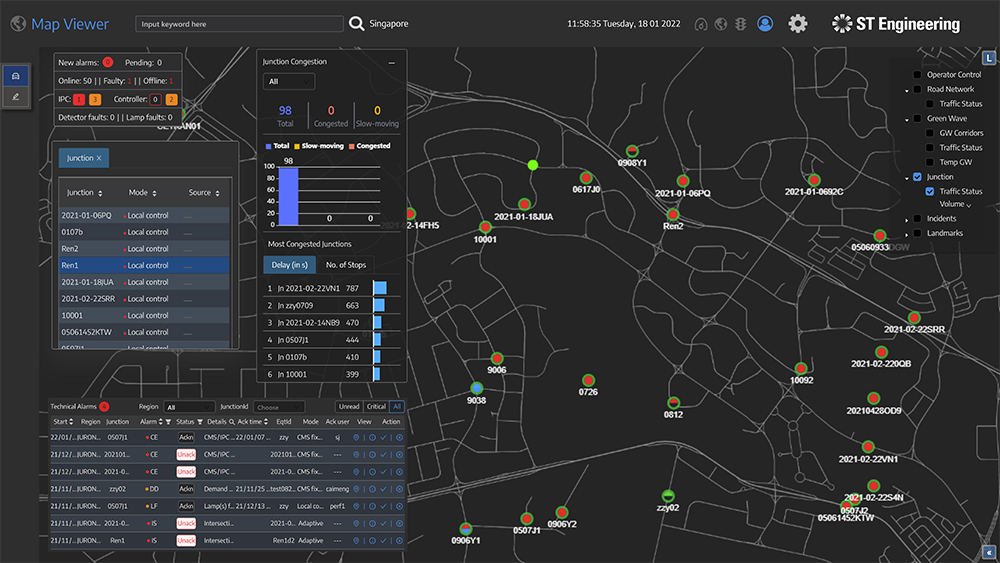ST Engineering’s Yeo Khiaw Ming explains why cities must explore the use of advanced technologies that enable more intelligent traffic signal control.
 Most traffic signal control solutions are legacy systems that cannot dynamically manage junctions and intersections
Most traffic signal control solutions are legacy systems that cannot dynamically manage junctions and intersections
Globally, more than 1.4 billion1 vehicles ply the roads daily. As this number continues to grow, managing road networks has become progressively challenging.
Most traffic signal control solutions are legacy systems that cannot dynamically manage junctions and intersections – the critical components of our road networks – in line with changing traffic conditions. They rely on pre-programmed timings, or use basic traffic sensors that cannot support future mobility requirements such as connected and autonomous vehicles (CAVs) and vehicle-to-everything (V2X).
At their core, smart junctions are defined by advanced traffic signal control systems that are integrated into a city’s wider traffic control solutions
When traffic signal control systems are not equipped with the latest technologies that can handle the sheer volume and complexities of modern urban traffic, junctions are not managed optimally to ensure more seamless vehicles and pedestrian flows with minimal stops and disruptions.
New and emerging advanced technologies that enable more intelligent traffic signal control are now giving urban traffic control centres the tools they need to ensure that these crucial elements of a city’s road network can be managed as simply and efficiently as possible, while ensuring they are future-proofed to incorporate data from different sources for optimised junction management.
At their core, smart junctions are defined by advanced traffic signal control systems that are integrated into a city’s wider traffic control solutions. The user interfaces of conventional junction management platforms have a steep learning curve, and traffic control centre system operators require extensive, costly training to comprehend the complete system. As a result, many of the features are unused.
While legacy systems can be difficult to operate, and also difficult to learn, modern systems seek to make data entry, operation and reporting as simple as possible, such that traffic control system operators can extract all the value the system provides. Modern systems no longer rely on command-line or text-based display outputs, for example, but show more intuitive graphical visualisations, offering operators a quicker route to the required action that would enable more effective traffic flow.
There are three core facets of smart junction management solutions that cities and transport authorities should look for:
 ST Engineering’s AI-driven AGIL Smart Digital Junction Suite
ST Engineering’s AI-driven AGIL Smart Digital Junction Suite
These three elements provide traffic authorities with the tools they need to better react to changing traffic patterns and unexpected traffic disruptions without the need to manually update traffic data. Within these systems are big data analytics supported by AI that provide operators with real-time monitoring and control over junctions, as well as the ability to improve long-term traffic engineering strategies and planning.
Taking a long-term view is one of the major benefits of the latest traffic control systems. Not only do they ensure that traffic authorities are better prepared for future scenarios and situations, they are also future-proofed for changes in the mobility landscape, especially as further automation, digitalisation and advanced communications continue to make the sector more intelligent.
As cities and their mobility mix evolve, so will smart junctions and their underlying technologies. Traffic authorities should look for systems that are traffic controller agnostic and therefore compatible with existing controllers. To date, authorities could only work with a limited range of traffic controller hardware that is compatible with their system.
Thankfully, the latest signal control systems are changing the status quo by introducing a layer between the controller and the system for greater flexibility and agility. In this way, authorities will have greater control over the hardware they use, and a clearer, more accessible upgrade path that allows them to scale more easily.
 AGIL Smart Digital Junction Suite harnesses real-time datasets from richer sources of data,
AGIL Smart Digital Junction Suite harnesses real-time datasets from richer sources of data,
simplifies and optimises junction management for traffic controllers.
The latest systems enabling smart junctions should be able to harness real-time datasets from richer sources of data, many of which we’re only beginning to see being trialled in cities, and whose peak deployment is not anticipated for another five to 10 years. These include technologies such as connected and autonomous vehicles, V2X-enabled infrastructure, and as part of that, data from more advanced sensors, such as lidar.
Scalability is critical, and supporting it in this context means embedding edge processing that can support an array of new sensors including AI based machine vision and crowd-sourced data.
Smart junctions can add value to the city experience when cities invest in the right signal control system that caters for future expansion with a cost-effective approach.
For cities themselves, and more specifically their traffic authorities, the ability to leverage richer data sources to improve traffic flow and junction efficiency can also deliver benefits in urban planning, helping planners to easily identify and solve challenges around urbanisation and population density as they affect road networks.
By better managing traffic flow and minimising vehicle stops and idling, cities can also count smart junctions as a tool to reduce pollution and contribute to climate action targets. Similarly, this will contribute to liveability metrics for citizens through improved driving and commuting conditions, thanks to reduced delays.
Smart junctions can add value to the city experience when cities invest in the right signal control system that caters for future expansion with a cost-effective approach
There are also benefits for service vehicles such as buses and emergency services, which can become more efficient through the prioritised deployment of right of way at junctions. What’s more, the future-ready traffic signal control systems mean that smarter junctions will be ready to support commuter-centric mobility services to become autonomous, embracing a commuter-centric V2X ecosystem.
Having successfully deployed more than 200 smart mobility road projects in 40-plus global cities, ST Engineering recently debuted its AGIL Smart Digital Junction Suite, which taps advanced AI and edge processing technology, to simplify and optimise junction management for traffic controllers. The solution also supports emerging and future technologies such as lidar, video analytics and V2X connectivity.
Discover how this solution can help your city revolutionise conventional junction management to address challenges faced by traffic controllers while overcoming urbanisation issues at www.stengg.com/smart-junction-suite.
References
1. Hedges & Company